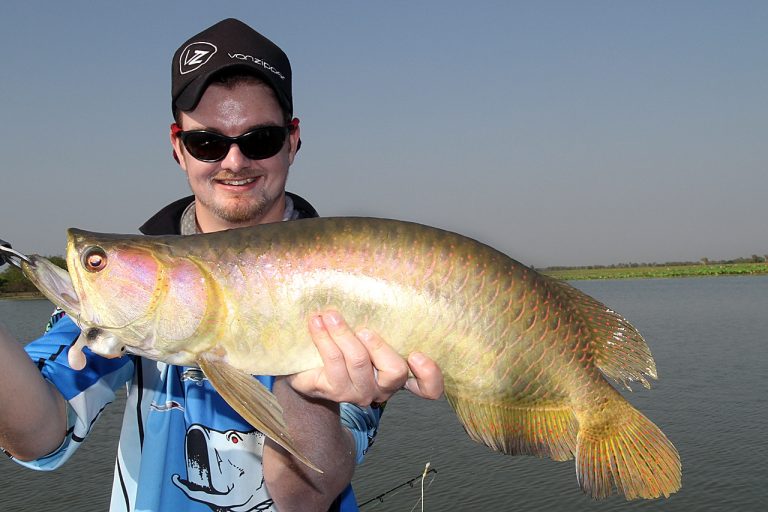Lilies – Friend or Foe?
By Lee Brake
Last week I headed for Teemburra Dam, a place I hadn’t ventured in months. My aim was to hook into a few of the barramundi that this dam is known for, but it was always going to be a risky trip.
You see, Teemburra has suffered in the last few years and is going through a bit of a rebuild. Hundreds, probably thousands, of big barra went over the wall during the floods and since 2010 it really hasn’t been the same dam. Once known as a place for numbers of barra of various sizes, it is now a very challenging affair. The good news is thanks to the efforts of the Mackay Area Fishing Stocking Association (MAFSA) the fishery is returning to its old glory. Gun local impoundment anglers have been reporting some red hot sessions on 100mm soft plastics and I was keen to see this for myself.
But Teemburra has a difficulty level above other dams like Kinchant and Faust that is the result of more than just fish going over the wall. It’s chock-a-block full of trees, fallen timber, gulley’s, creek beds and weed edges. All of which can and do hold fish… if you could get to them and pick the right ones.
The whole dam is currently ringed with a mat of lily pads some ten metres deep in places. Most of my favourite snags are so far back in the mats I’d need a packed lunch and a road map just to find them!
This did my head in. I tried everything and eventually retired defeated. In this case the lily pads were certainly not my friend. They were too thick and densely packed to fish with even weedless rigged lures – though I tried – and they were in quite deep water as well, which meant that rather than patrolling the edges, the barra could actively move and feed under the mats.
This all may seem like doom and gloom, but like anything, there’s a silver lining. You see, lily pads can be awesome fish producers and if we get some rain to spread them out in Teemburra, the place should be amazing.
Some of the best fishing I’ve experienced was amongst the lily pads of Corroboree Billabong near Darwin. I was fishing with Colin Burdon of Reidy’s Lures for the day using his Reidy’s Weedies, a weedless rigged soft plastic specifically designed for working dense snags and weeds, like lilies. Up until that point I’d never caught a Saratoga and I was in for a real treat. The lilies lined the banks, but there were plenty of small channels and gaps running through them. I’d cast the Weedies up into these gaps, usually land them on a lily, then “plop” them into the water and slow roll them out. Most times we’d actually see the ‘toga coming. You’d see a ripple beside a lily pad or a tiny glimpse of dorsal fin and then you could track the fish’s progress until suddenly the lily pads near the Weedies would be displaced and there would be a spray of white water and a greeny, silver splash on the surface. The braid would go tight and it’d be on for young and old. The key seemed to be resisting the urge to strike as soon as the fish rolled on the lure. If I let the braid go tight first it made a big difference and usually resulted in a perfect jaw-hinge hook-up. That day we saw, hooked and caught more Saratoga than I could count.
I used these same tactics to great effect in Teemburra and Kinchant that same year and would regularly find barra willing to take weedless rigged lures from the gaps and edges of the lily mats. One particularly lethal technique involved using Gulp 7″ Jerkshads rigged weedless and flicked right up into the shallows. These could then be worked out with a slow, constant one-two retrieve that saw the lure slowly waft from side to side as it moved subsurface and even hopped over and around lily pads. It looked a lot like a lizard that was swimming and floundering across the shallows. The resulting strike when a barra engulfed if from underneath was breathtaking and I’ll admit to going week in the knees many times.
Lily pads really are the ultimate cover for many fish. During the day they provide cover from above from birds as well as a web of submerged stalks and roots to protect from swimming threats, but as the sun gets low on the horizon, things change. Sooty grunter, barra, bass and saratoga will usually move to the edge of the lily mats – which is usually a drop-off by nature – and use them as an ambush point to hunt everything from insects to the small fish which feed on them. This makes working surface lures and stick baits around these edges a lethal activity at dawn and dusk!
I’ve had some awesome sessions at Eungella Dam – often touted as the greatest sooty grunter impoundment in the world – by working dark coloured poppers the size of my thumb along the lily edged bays and points. Sooties hit a surface lure like a it’s the last feed they’ll ever have and it’s a thrill-a-minute way to fish.
So, to answer the question posed by the title of this article – friend or foe – I’d have to say both. Most of the time they are the ultimate fishy cover and are perfect places to find congregated fish, but that’s only if you can access them through gaps and channels. Otherwise, they provide the perfect angler-proof cover as well!





